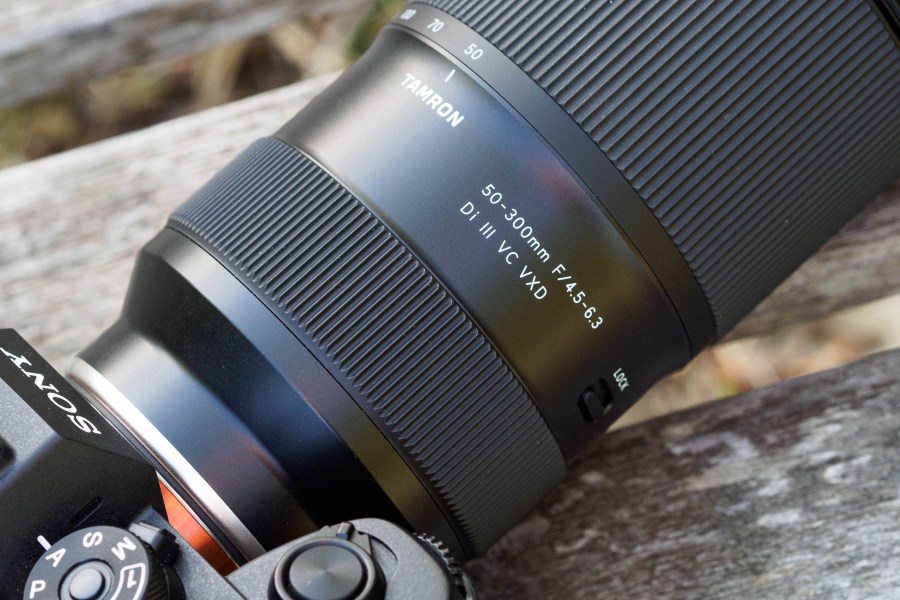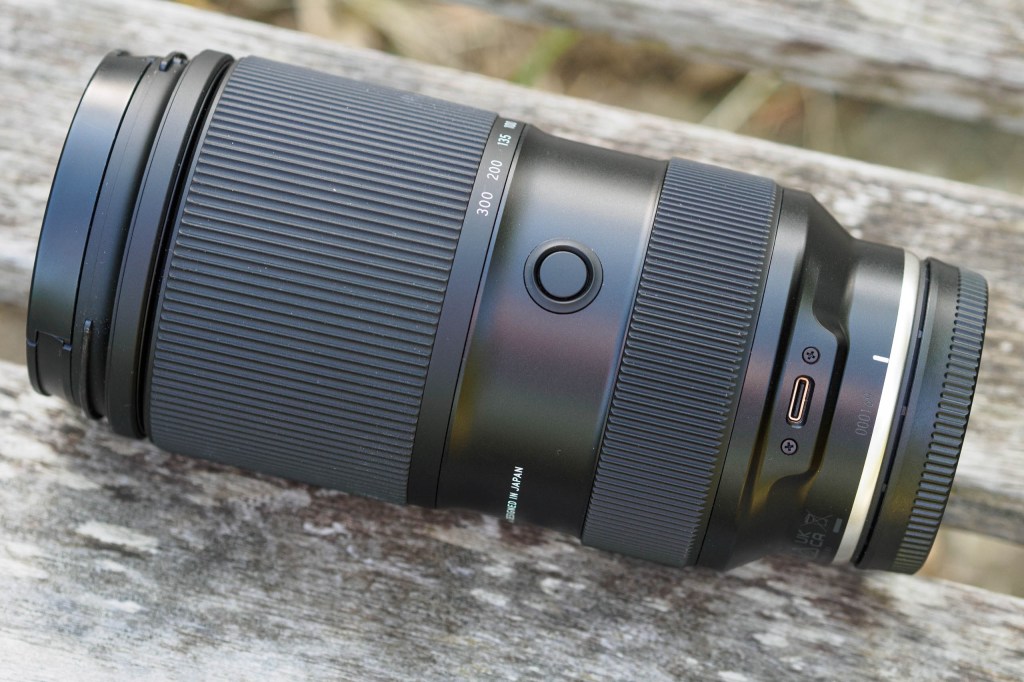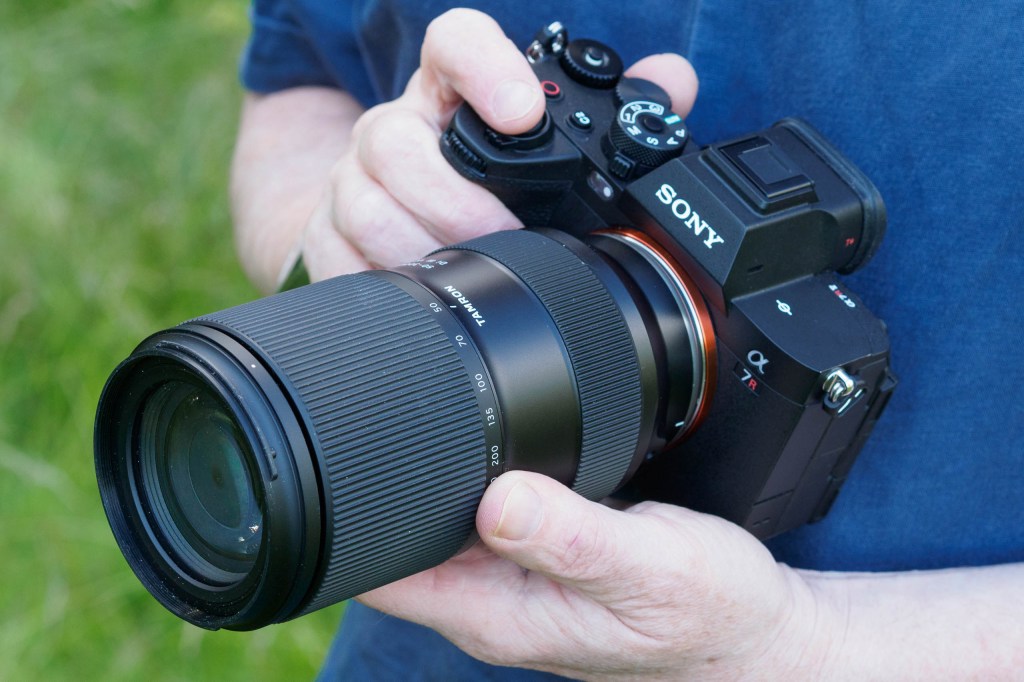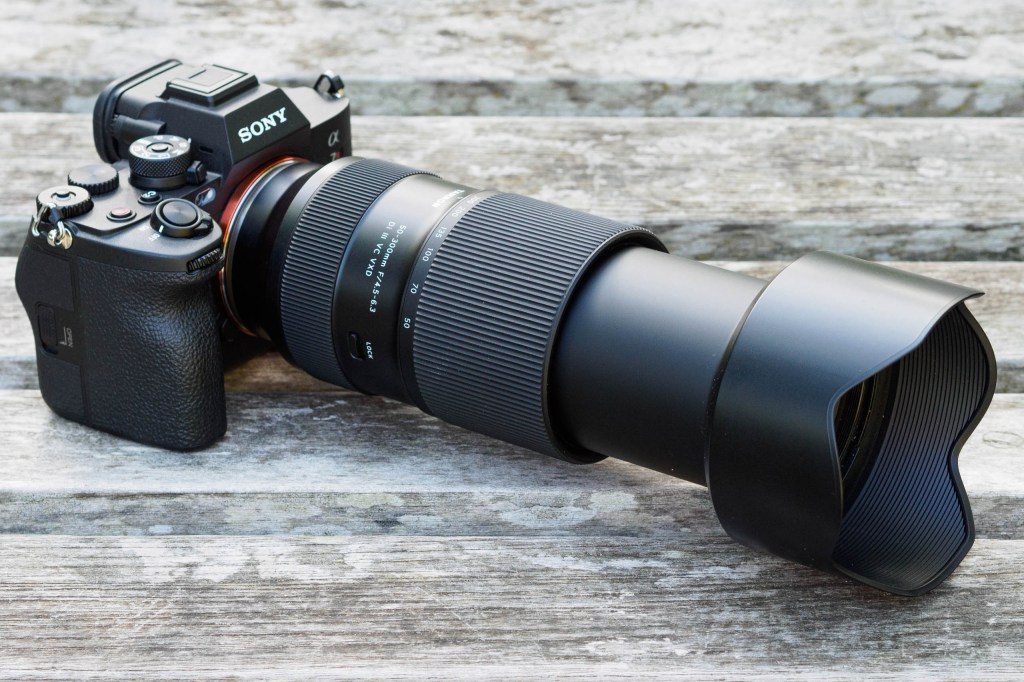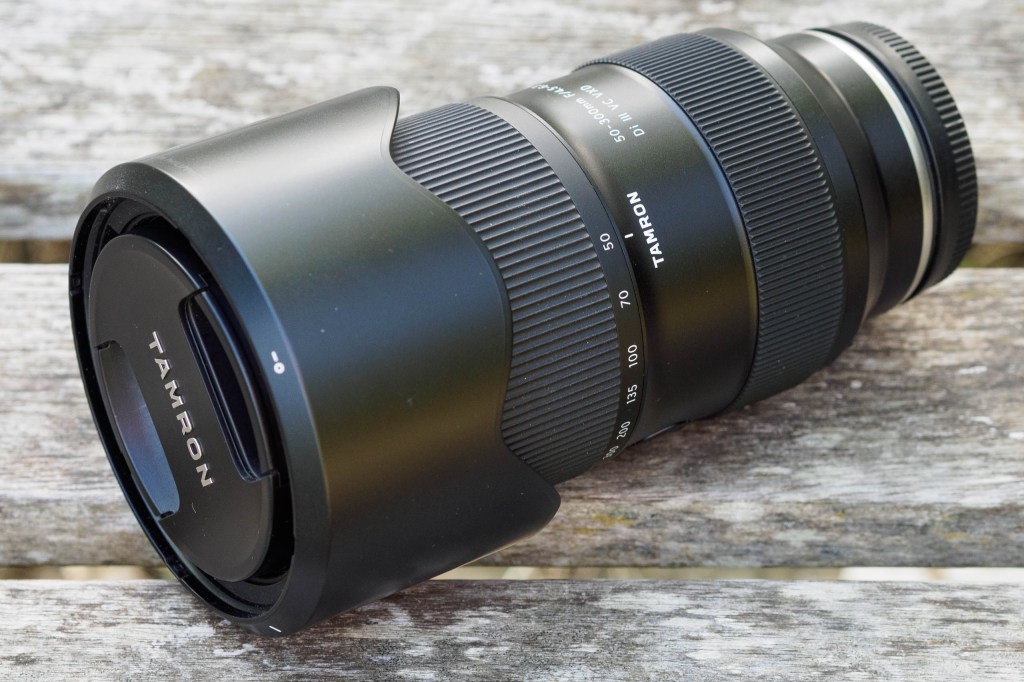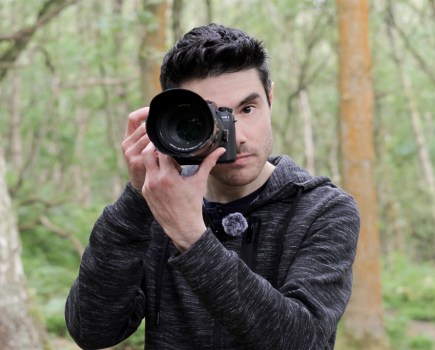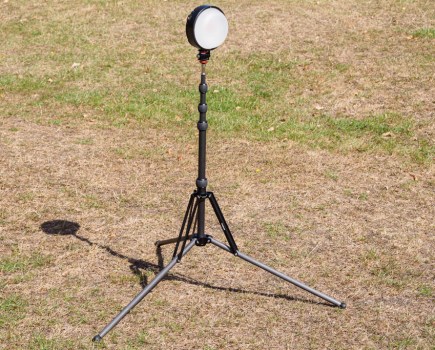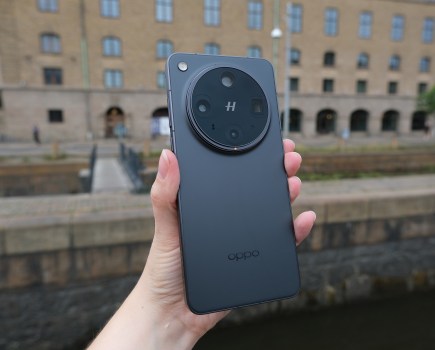Amateur Photographer verdict
With a compelling blend of versatility, portability, and high image quality, the Tamron 50-300mm F/4.5-6.3 Di III VC VXD is a great option for Sony full-frame users. It’s handy for close-ups, too.- Relatively small and lightweight
- Really useful zoom range
- Impressive close-up ability
- Delivers clean, detailed images
- Fast, accurate autofocus
- Restricted maximum aperture
- Slightly soft edges and corners at the long end
The Tamron 50-300mm F/4.5-6.3 Di III VC VXD is a telephoto zoom lens that’s designed for use on full-frame mirrorless cameras. Initially it’s available in Sony E mount only and costs $799 / £819. It can also be used on APS-C cameras, on which it will give a 75-450mm equivalent range. Offering a compelling blend of a useful zoom range, high image quality, and compact size, it’s one of the best Sony E-mount lenses around, especially if you value portability.
At a glance:
- $799 / £819
- Standard to telephoto zoom
- For full-frame cameras
- Built-in vibration compensation / optical stabilisation
- Minimum focus 22 – 90cm
- 67mm filter thread
- 75mm diameter x 150mm length, 665g
- Sony E-mount
This type of 300mm telezoom has been distinctly overlooked by manufacturers recently, in favour of 100-400mm optics. It’s not entirely clear why, as such lenses are considerably smaller, lighter, and more affordable. This makes them a tempting choice if you’re on a tighter budget, or don’t fancy lugging around a lens that weighs well over a kilogram.
While this 50-300mm clearly follows on from Tamron’s older 70-300mm F/4.5-6.3 Di III RXD, it’s really a new lens in its own right. It gains built-in optical stabilisation, a faster autofocus motor, and a wider start point to the zoom range. You might think that latter point is unimportant – surely what you want from a telephoto zoom is for it to be as long as possible? – but as it turns out, that rather misses the point.

Before we jump too far ahead of ourselves, though, let’s compare this lens to some alternatives. Despite all its new features, it’s barely any larger than Tamron’s older 70-300mm, however it is 120g heavier, and much higher priced. On the other hand, Sony’s FE 70-300mm F4.5-5.6 G OSS is about 200g heavier and considerably more expensive again. In this price bracket you might also consider the excellent Sigma 100-400mm F4.5-6.3 DG DN C, but unsurprisingly it’s a much larger lens, being 30% longer and 70% heavier.
Together, this all means that the Tamron 50-300mm could well be the ideal telephoto zoom for many Sony E-mount users. But does it have any significant drawbacks?
Tamron 50-300mm F/4.5-6.3 Di III VC VXD: Features
With its 50-300mm range, this lens is ideal for shooting distant subjects or details. However, its 50mm wide end means it also counts as a ‘standard’ zoom. As a result, you can keep it on the camera for longer and change lenses less frequently, compared to a conventional 70-300mm.

This should also make it a useful complement to short standard zooms such as the Sony FE 24-50mm F2.8 G or Tamron’s own 20-40mm F/2.8 Di III VXD. Indeed, when paired with the Tamron 17-50mm F/4 Di III VXD, you’d be able to cover a 17-300mm range, for which you’d normally expect to need three lenses.
Tamron has used an optical design with 19 elements in 14 groups, including two made from low-dispersion (LD) glass and two from extra-low dispersion (XLD) glass to combat chromatic aberration. The firm’s BBAR G2 (Broad-Band Anti-Reflective) coating suppresses flare and ghosting, while a 9-blade diaphragm forms the aperture.

A Voice-coil eXtreme-torque Drive (VXD) motors powers the autofocus. The lens can focus as close as 22cm at the 50mm setting, corresponding to an impressive half life-size magnification. Zoom to 300mm and the minimum focus distance increases to 90cm, but this still gives a very respectable 0.32x magnification.
Optical image stabilisation (or vibration compensation, as Tamron calls it) is also onboard. But the firm doesn’t provide any rating in terms of stops of shake reduction.
Reassuringly for a lens which is likely see most of its use outdoors, the barrel boasts moisture-resistant construction. There’s also a fluorine coating on the front element to repel grease and water. A deep petal-shaped hood comes in the box, while the 67mm filter thread is shared with many of the firm’s other lenses.
One notable feature is the inclusion of a USB-C port, which allows the lens to be connected to a computer or Android smartphone. Using Tamron’s Lens Utility software, it’s possible to update the firmware if necessary, and tweak the behaviour of the controls. This can be a really useful feature and I wish all lenses worked this way.
Tamron 50-300mm F/4.5-6.3 Di III VC VXD: Build and Handling
Despite its wider start-point, the Tamron 50-300mm is no larger or heavier than a conventional full-frame 70-300mm zoom. It measures 75mm in diameter and 150mm long when set to 50mm, while weighing in at 665g. Zoom to 300mm, and the barrel extends by almost 6cm. I mainly used the lens on the Sony Alpha A7R V and found the two worked very nicely together. But it also handled pretty well on the older Alpha A7 II, which has a much smaller handgrip.
In terms of build and design, this is much the same as other recent Tamron lenses. The barrel feels sturdily made of high-quality plastics, and both the zoom and focus rings operate nice and smoothly. At the back, the metal mount is surrounded by a rubber seal to protect the camera and lens from dust or water getting inside.
One point worth mentioning is that the image stabilisation unit rattles slightly disconcertingly, unless the lens is attached to a camera and powered on.
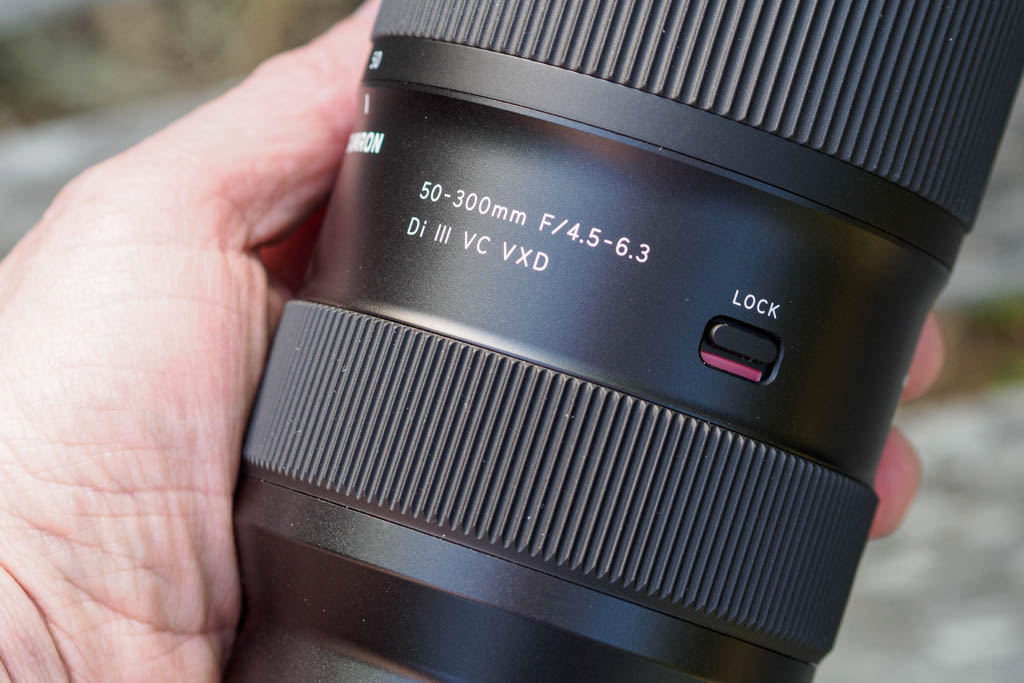
The zoom ring covers most of the front half of the barrel and falls nicely to your hand when shooting. A small switch locks the zoom at 70mm when you’re not using it.
By default, the manual focus ring operates in a non-linear fashion, with the rate of change in distance depending on how fast you turn it. But if you prefer, you can switch to linear operation using Tamron Lens Utility, with a choice of rotation angles from minimum focus to infinity.
The only other control is a button on the left side of the barrel. Initially, this is set up to replicate whatever function you’ve set for the AF Hold button on Sony lenses. But again, you can change this in Tamron Lens Utility, for example to toggle between autofocus and manual, or engage a focus distance limiter to reduce autofocus hunting.
Tamron 50-300mm F/4.5-6.3 Di III VC VXD: Autofocus
It’s not so long ago that Tamron’s DSLR lenses offered somewhat slow and unrefined focusing. But those days are now past, with the 50-300mm instead providing rapid, silent and unerringly accurate autofocus. You can’t expect quite the same performance as from Sony’s own premium lenses, which can track focus during stills or video shooting at 120fps. But what you do get is still very capable indeed.

In my testing, the Tamron 50-300mm worked seamlessly with the A7R V’s subject detection and tracking, and had no problems keeping up with the camera shooting at 10 frames per second. Its main weakness comes when trying to adjust focus from a distant subject to a much closer one, where it’ll often just get stuck on background detail instead. But that’s a common problem, and it can be overcome either by forcing the lens to focus on something closer that fills the frame, or using Sony’s DMF mode which gives full-time manual focus override.
Tamron 50-300mm F/4.5–6.3 Di III VC VXD: Performance
Probably the main reason why 300mm telezooms fell out of favour is because they became cheap kit zooms for DSLRs, and gained a reputation for giving soft images, especially at 300mm. However, it’s often overlooked that arguably the biggest advantage of mirrorless systems is the sheer quality of the optics. That’s very much the case again here, with the Tamron 50-300mm F/4.5–6.3 Di III VC VXD delivering excellent results that stand up well to scrutiny even with the A7R V’s 60MP sensor.

Click on any image to see a full-resolution version
Looking first at resolution, it’s evident that the lens gives extremely high levels of sharpness in the centre of the frame at all focal lengths, even with the aperture wide open. This sharpness extends across pretty much the entire image at 50mm. But when you zoom to 300mm, there’s a slight but noticeable drop-off in crispness towards the corners, if you view your images at 100% onscreen.

However, it’s important to keep this in context. In real-world use, you’ll normally lose far more detail due to either the inherently shallow depth-of-field of this kind of lens, or the blurring effect of diffraction if you stop down beyond f/11. On this note, the lens offers minimum apertures of f/22 at 50mm and f/32 at 300mm; these can be useful when you need extended depth of field, but the images get very soft indeed at the pixel level.

When it comes to curvilinear distortion, the lens delivers almost entirely neutral images at 50mm. But then pincushion distortion rapidly becomes evident on zooming in, reaching a maximum at about 135mm. However, this distortion will be corrected perfectly in the camera JPEGs if you set in-camera Distortion Comp to Auto. You can see a comparison below between uncorrected (left) and corrected images (shot at 135mm).


Distortion will also be automatically corrected in raw processing with Lightroom and Camera Raw, just as soon as Adobe has profiled the lens. It has a very simple pattern, too, which means it’s easy to fix near-perfectly using generic correction sliders. For many of the subjects you’ll use this lens for, it’s unlikely to be a huge problem anyway.

A little vignetting can be visible when shooting evenly-toned subjects with the aperture wide open. But it reduces substantially at f/8 and disappears by f/11. Enable shading compensation in-camera, and it’ll be fixed automatically in both JPEG and raw files.

Chromatic aberration is corrected automatically in JPEG files by default, and there’s no sensible reason to turn this off. Likewise, a compensation profile is included in raw files and applied automatically by Adobe software. The practical upshot is that I only ever saw tiny vestiges of colour fringing in any of my images – it’s really not something that you’ll ever need to worry about.

The lens’s impressive performance extends to close-up shooting, too. You’ll get the highest magnification at 50mm, but this requires placing the lens just a centimetre or two from your subject, which often means getting in your own light. So I usually preferred backing off and zooming in a bit.
It’s always worth bearing in mind, though, that at high magnifications and with a long lens, you’ll need faster shutter speeds than you might expect to get sharp images. Don’t expect the 1/focal length rule-of-thumb to work.
While this lens doesn’t have a particularly large aperture in terms of f/number, its long focal length means you can get substantially blurred backgrounds, especially at relatively close focus distances. I’ve been pleased by the bokeh in my sample images, which is nice and smooth.
Tamron 50-300mm F/4.5-6.3 Di III VC VXD: Our Verdict
I really enjoy shooting with telephoto lenses, but not necessarily carrying around full-frame 100-400mm zooms. This means the Tamron 50-300mm F/4.5–6.3 Di III VC VXD is naturally right up my street. I’ve been pleasantly surprised by how much more versatile it is than conventional 70-300mm optics, thanks to its 50mm start-point and impressive close-up abilities. This is a lens I’d happily keep on my camera a lot of the time.

Indeed, there’s a great deal to like here. It’s light enough to carry around all day, the autofocus is fast, silent and accurate, and it gives clean, detailed images. Its main practical drawback is the relatively limited maximum aperture, but that’s an inevitable trade-off for the compact size. And while sharpness is generally very impressive, at the telephoto end it’s not quite as high towards the corners and edges. But in real-world use, those areas won’t often be in focus anyway, so it doesn’t really matter.

That said, this lens isn’t going to appeal to everyone. If you value such things as pixel-level detail and shallow depth-of-field above all else, it may not be for you. However, If I were travelling with a Sony full-frame system, it would be right at the top of my list.

Follow AP on Facebook, Twitter, Instagram, YouTube and TikTok.
Tamron 50-300mm F/4.5–6.3 Di III VC VXD full specifications
| Price | £819 |
| Filter Diameter | 67 |
| Lens Elements | 19 (2 XLD glass, 2 LD glass) |
| Groups | 14 |
| Diaphragm blades | 9 |
| Aperture | f/4.5-6.3 – f/22-32 |
| Minimum focus | 0.22-9m |
| Length | 150mm |
| Diameter | 75mm |
| Weight | 665g |
| Lens Mount | Sony E (fill frame) |
| Included accessories | Caps, hood |

